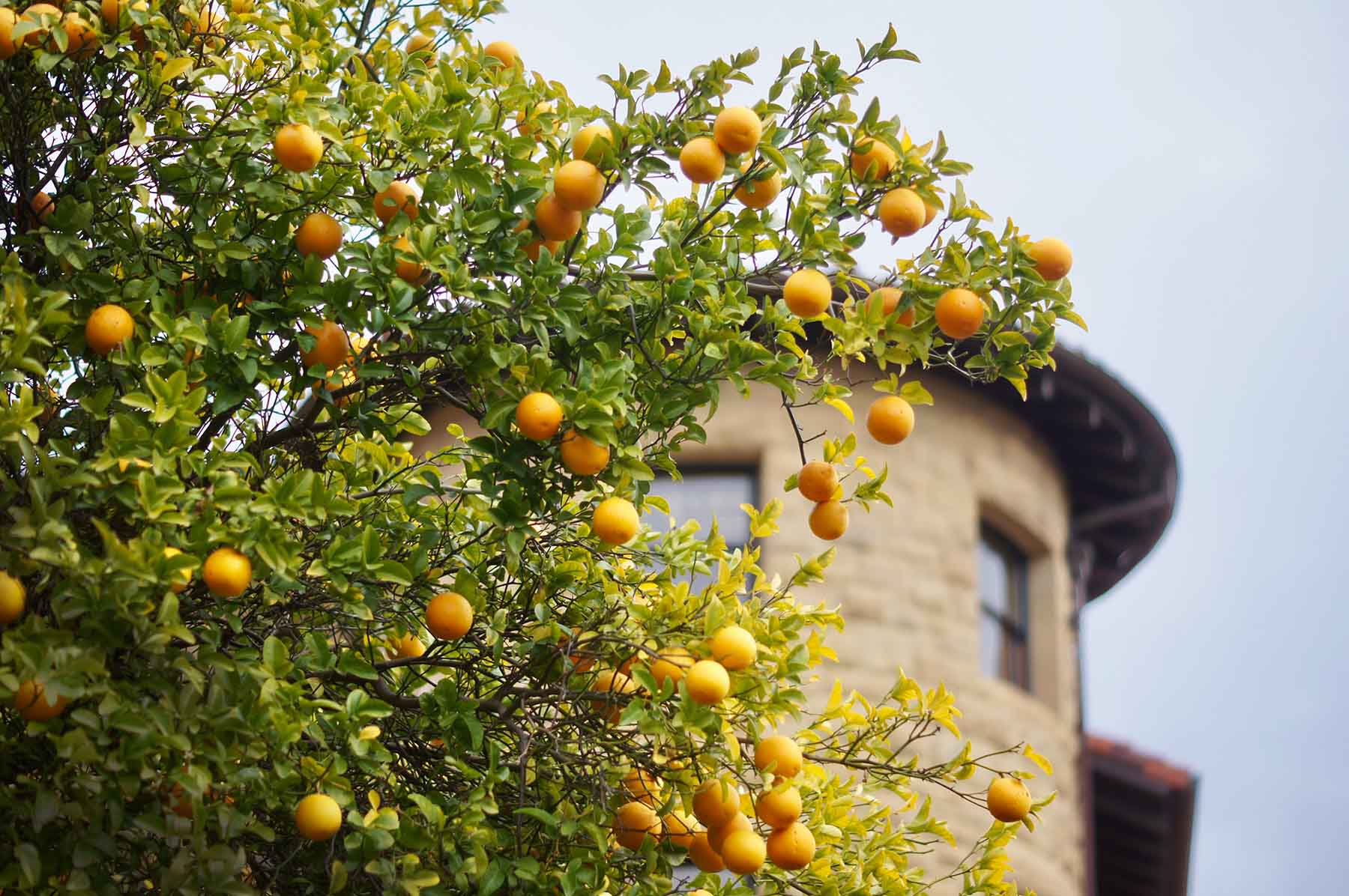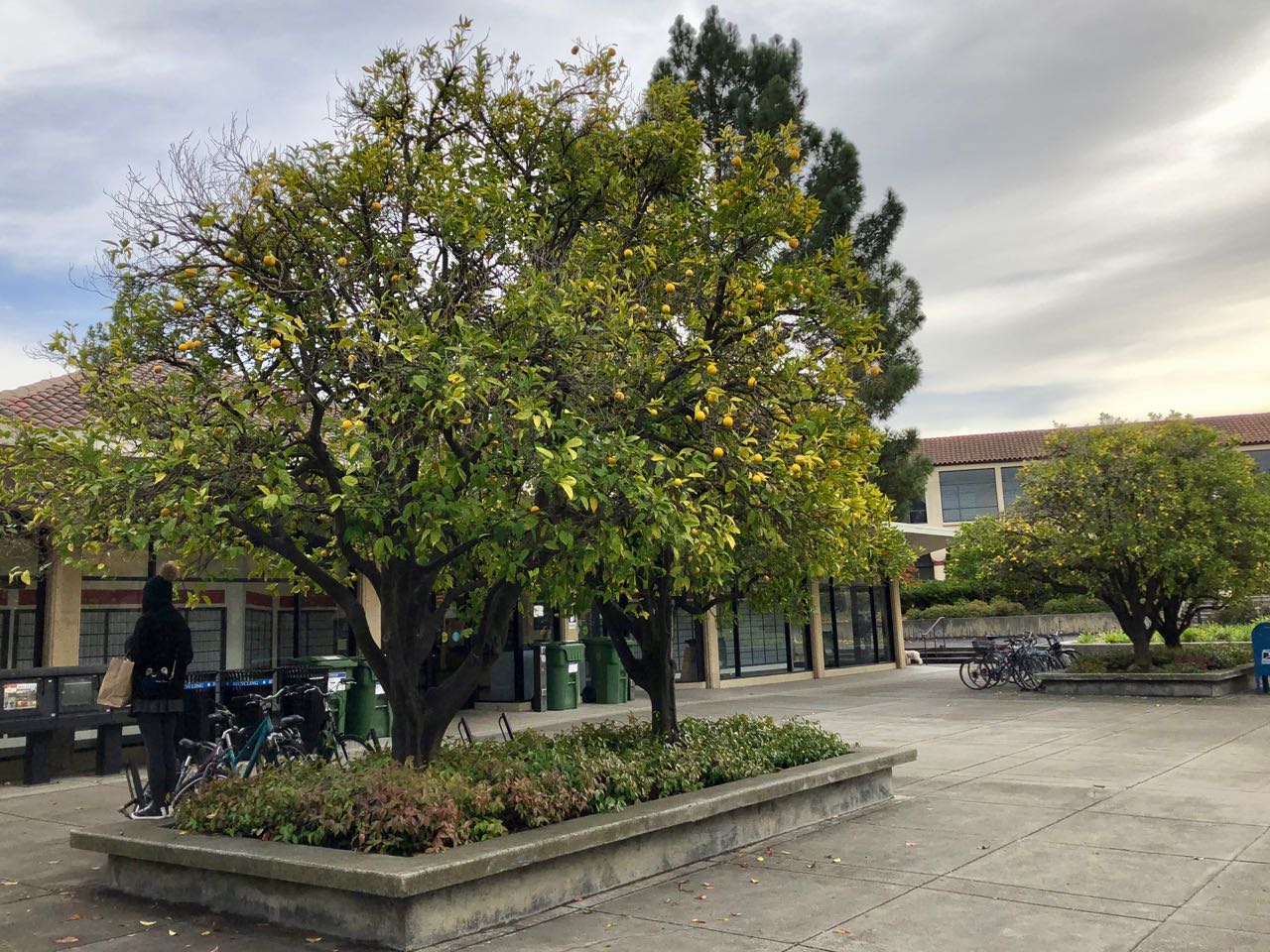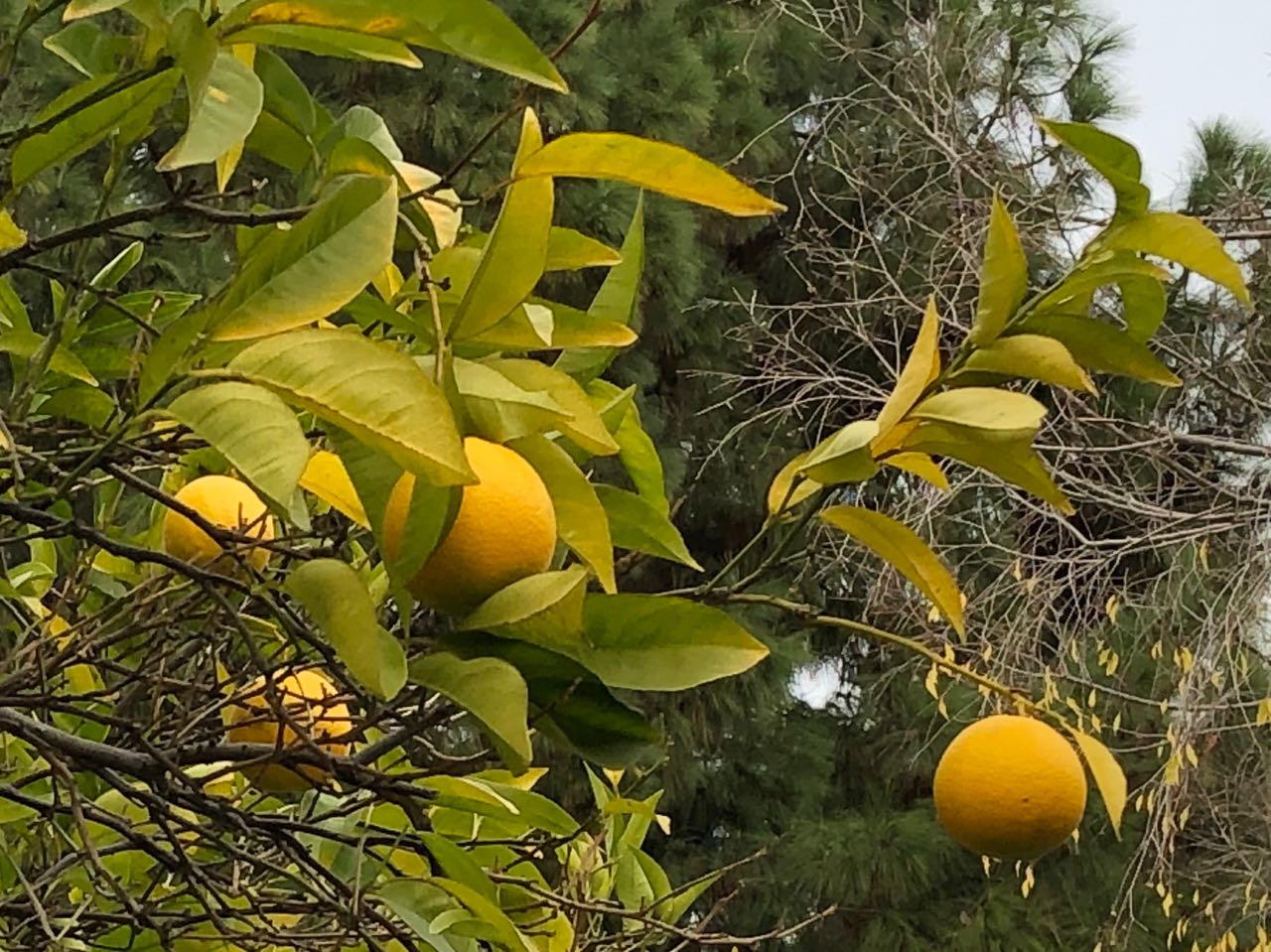Citrus Notes


One of the most striking features of campus to those from chillier climes is the prevalence of citrus trees, almost every building seeming to have some next to it or nearby, in sunny spots against walls or corners that guard against the effects of our mild frosts on these tender tropicals.
The Citrus Courtyard, between the History building and Inner Quad, started to be planted in 1915 and still boasts the most varieties in one spot. John McLaren, superintendent of Golden Gate Park and advisor to Stanford for its planting plans, had suggested using groups of semi-tropical trees and shrubs in that courtyard, with hedges along the edges. Before that, the courtyards between the Inner and Outer Quad buildings remained unlandscaped, even though a 1988 drawing by Frederick Law Olmsted shows them lush with trees and shrubs. After the courtyard surface was leveled by filling in with dirt, groups of oranges and lemons were planted. Cars could continue to drive into the courtyard; they were banned only much later.
Citrus originated in the Malay Archipelago and southeastern Asia, then traveled westwards to Africa and the Mediterranean. Columbus himself introduced the orange to the New World. Most botanists agree there are three ancestral species from which almost all the citrus we enjoy today descend: the thick-rinded citron (C. medica), the maximally sized pomelo (C. maxima), and the mandarin (C. reticulata). Various scientific names have been given to citrus trees over time; currently competing classifications have not been resolved.

Our sweet orange (C. × sinensis) came out of crosses between the pomelo and mandarin. There are two main types, the Valencia – the most commonly grown – and the navel.
The ‘Washington’ navel orange was selected from an orchard in Brazil and brought to Washington DC (hence the cultivar name) from which it was cloned and distributed. Most significantly, a pair sent to a home in Riverside, California in 1873 ended up being the trees from which almost all navels in the world today are descended. You can still pay your respects to the remaining tree (California Historical Landmark No. 20). Its fruit has a belly button–like depression in the blossom end, the end opposite the stem. As if to elaborate on the umbilical allusion, tucked behind this navel is an embryonic mini-orange, often with its own segments, which is interesting to examine. But the reason the orange is popular is its seedlessness and rich sweet flavor.
Ripeness in oranges is hard to assess, and they ripen only on the tree; avocados and apples can ripen off the branch. Nighttime temperatures of about 40 degrees are ideal for the skin of an orange to actually turn the eponymous color. Campus temperatures in winter tend to be cooler, but most of our oranges show good color. Commercial oranges are treated with ethylene gas to make their skins turn the color humans want to see in supermarkets, even though a green one may be at peak sweetness.
The oranges at the right of the entrance to Building 170 tend to ripen in February; they have deep green leaves. There are oranges in two planters in front of the Post Office.
The word orange is from Old French orenge, which goes back to Persian nārang to Sanskrit nāraṅga, which reaches back into the Dravidian.
The kumquat is the citrus most readily available on campus. You can pop these golden oval fruit, which are about an inch across, right into your mouth, rind and all. Ours ripen in March. See slender but ancient kumquat trees rising out of the hedges in the passageways that lead from the Quad’s east entry into the Citrus Courtyard and into the southeast courtyard (Language Corner). Others are in the center of the Citrus Courtyard next to the late-blooming saucer magnolia and in the northwest courtyard of Stern Hall. Its name comes from Cantonese for gold (kam) and orange (kwat). Kumquats retain their vivid colors on being preserved whole in syrup. Kumquats were brought back from China by Robert Fortune, from his 1846 venture for the Royal Horticultural Society. The kumquat genus, Fortunella, was named after him, though kumquats have now been lumped into Citrus by some. Fortune also introduced the tea plant (Camellia sinensis) to India.
Lemons (C. × limon) are a hybrid between the citron and the bitter orange (C. × aurantium). ‘Eureka’ is the classic culinary selection, with sharp acid flavor and zesty rind; new leaf growth is bronzy purple. Somewhat sweeter is the ‘Meyer’ (technically the virus-free ‘Improved Meyer’ clone), which has a thinner rind with a slightly orange cast. Both can bear year-round. We get the word lemon via French from Arabic laymūn.
The Buddha’s Hand citron (C. medica var. sarcodactylis) grows in Citrus Courtyard, on the patio leading to the entrance to Building 200. Its fruit extends out into a number of finger-like segments of all rind and no pulp. The small tree is not frost tolerant.
On the right of the stairs leading down to the sunken adjacent patio is a heavily bearing citrange (C. × insitorum, syn. × Citroncirus sp.), a cross between the trifoliate orange (C. trifoliata, syn. Poncirus trifoliata) and the sweet orange. The trilobed leaves (or mostly so) and fierce long thorns are characteristics of the former, as is the cold tolerance and disease resistance of this hybrid, leading it to be used primarily as a rootstock, with ‘Troyer’ (‘Carrizo’) being its most common selection in California. Its perfectly round fruit is about 2¼ inches long. Our tree is the result of the rootstock overwhelming its former declining scion. It fruits prolifically and conspicuously in January and February, attracting much attention. Its flesh is bitter and packed with seeds, but its skin has a marvelously floral fragrance. Pick some off the ground and put them on your desk; delight friends by offering them a sniff!
- Main References for New Tree Entries.
- “Inner Quad to be Paved Again” (Jan. 1915), Stanford Alumnus, Volume 16, pp. 169–170. Stanford Archives.
- “Orange Trees for the Quadrangle Courts” (Feb. 1915), Stanford Alumnus, Volume 16, p. 228. Stanford Archives.
About this Entry: Authored Feb 2025 by Sairus Patel.



